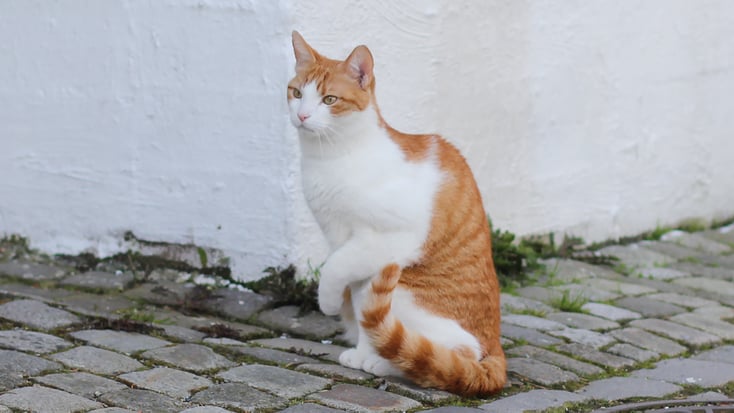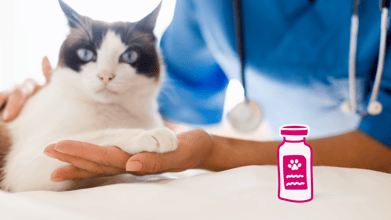Why Is My Cat Limping? A Vet's View

Table of Contents
Cat injuries can happen even when you least expect it. As playful, graceful, and agile as they are, feline pets can end up hurting their limbs just like we can and your cat limping may be the first sign you notice.
Here, we'll look at the possible causes of cat limping and highlight when you might need veterinary intervention.
5 Common Reasons Why Your Cat May Be Limping
Cat limping can be caused by various factors, including injuries, arthritis, infections, and paw injuries. Here is a breakdown of each possible reason:
1. Injuries
It is the nature of cats to be curious and explore their environment. Injury-related limping could be caused by jumping from an open window or high perches in your house which then can lead to breaking, sprains, and strains.
2. Arthritis or joint diseases
Joint diseases like arthritis might develop as your cat ages, causing joint inflammation and pain. They may cause lameness in cats, demonstrated by limping, stiffness, and difficulty climbing or jumping.
Is Your Cat Showing Signs of Osteoarthritis Pain?
1. Has difficulty jumping up or down.
2. Trouble climbing up stairs - your cat may stop halfway or “bunny hops” with both back legs at the same time.
3. Difficulty getting down the stairs - your cat may angle their body or go down one step at a time.
4. Less interest in playing/chasing - your cat may avoid active play or take frequent breaks.
5. Avoids running - your cat moves at a slower speed and alternates running with walking.
6. Changes in appetite - your cat is showing less interest in food.
7. Changes in grooming - your cat is not grooming as much as usual or is overgrooming certain areas.
8. Personality changes - your cat is less sociable than usual, is hiding more, or is resistant to being touched.
9. Changes in potty habits - your cat is having accidents inside the house or not using the litter box.
View Results
Is Your Cat Showing Signs of Osteoarthritis Pain?
1. Has difficulty jumping up or down.
2. Trouble climbing up stairs - your cat may stop halfway or “bunny hops” with both back legs at the same time.
3. Difficulty getting down the stairs - your cat may angle their body or go down one step at a time.
4. Less interest in playing/chasing - your cat may avoid active play or take frequent breaks.
5. Avoids running - your cat moves at a slower speed and alternates running with walking.
6. Changes in appetite - your cat is showing less interest in food.
7. Changes in grooming - your cat is not grooming as much as usual or is overgrooming certain areas.
8. Personality changes - your cat is less sociable than usual, is hiding more, or is resistant to being touched.
9. Changes in potty habits - your cat is having accidents inside the house or not using the litter box.
Share Quiz
3. Ruptured or injured muscles or ligaments
Torn tendons or muscles could cause pain, making your cat limp.
4. Infections or abscesses
Your cat can get bite wounds or insect stings that make them limp. Likewise, nails might grow inwards and lodge in the skin, causing intense pain.
5. Paw injuries
These include burns from walking on hot gravel or pavement as well as thorns or splinters in the paws.
When to Seek Veterinary Care
While some causes of limping can clear up with a day's rest, it's essential to consult a veterinarian for a proper diagnosis if you notice any of the following problems:
- Your cat is holding the leg in an odd position, which could indicate a broken bone.
- Your cat has an open wound or signs of injury like bleeding, discharge, or an infected smell.
- The limping does not resolve over a couple of days or progress.
Veterinary Diagnosis and Examination
As the pet parent, you'll be required to provide information about your cat's symptoms and history, which will assist the veterinarian in making a correct diagnosis.
The veterinarian will observe your cat's movements and carefully examine your pet for any visible cause of limping. This includes a check of your cat's paw on the painful leg to ensure they don't have anything stuck in their paw or any open wounds hidden between their toes.
Diagnostic testing is essential, where your veterinarian may carry out X-rays, tissue biopsy, fluid evaluation, or in some cases advanced imaging such as CT scan & MRI.
Treatment Options for a Limping Cat
Treatment options depend on the cause of the limping, but can include:
- Physical therapy, nutritional supplementation, & weight loss (if overweight): Recommended for injury-related limping, such as sprains and strains. Splinting or bandaging of the limb may be necessary for bone breaks or more serious joint injuries.
- Medications: Antibiotics are prescribed to treat infections; anti-inflammatories and pain management prescribed for arthritis and painful injuries. Other drugs may be needed that suppress the immune system or minimize inflammation.
- Advanced treatments: Chemotherapy, immunotherapy, or radiation treatment may be recommended if cancer is the cause.
- Surgical intervention: Surgery may be appropriate to clean out infected wounds (like abscesses) or repair broken joints or bones.
There is also a new medication called Solensia for cats that is a monthly injection to treat osteoarthritis pain.
Conclusion
When your cat is limping, it's an indication of feline leg pain. The injury could require home care or veterinary care. Cat limping can be caused by different factors, including broken bones, infections, bites, sprains/strains, arthritis, or cancer.
If the limping persists for more than two days or if your cat is in obvious discomfort, visit a veterinarian for an examination and diagnostics to identify possible causes and implement treatments. Consider preventive measures to reduce instances of injury in your cat.
Frequently Asked Questions
How can I prevent my cat from limping?
You can take preventive measures to keep your cat safe from paw injuries, sprains, and strains. This includes supplementing your cat's diet with joint supplements recommended by your veterinarian, ensuring your cat maintains a healthy weight, and creating a safe space for them to explore freely.
How can I care for my limping cat at home?
Confine your cat to a small space, prevent access to high places, and ensure closed windows when you're away. Consider using ice packs (wrapped in a towel) on sprains or breaks until you can reach a veterinarian. Schedule regular appointments with your veterinarian for general health checks.
Why is my cat limping but not crying?
Cats are typically quiet when they are in pain, so the absence of crying doesn't mean they are ok. It is a good idea to get the cat checked thoroughly to find the cause of the limping.
What does it mean if my cat is limping but still jumping and running?
Cats instinctively hide their injuries, so your cat running from time to time doesn't rule out an injury that's making them limp. You still need to call a veterinarian for an examination.
Can a limping cat heal itself?
This depends on the cause of the limping. Finding the cause requires a visit to the veterinarian. An infection or other complicated cases require medical attention. For muscle strain or sprains, proper first aid can give your cat relief.






